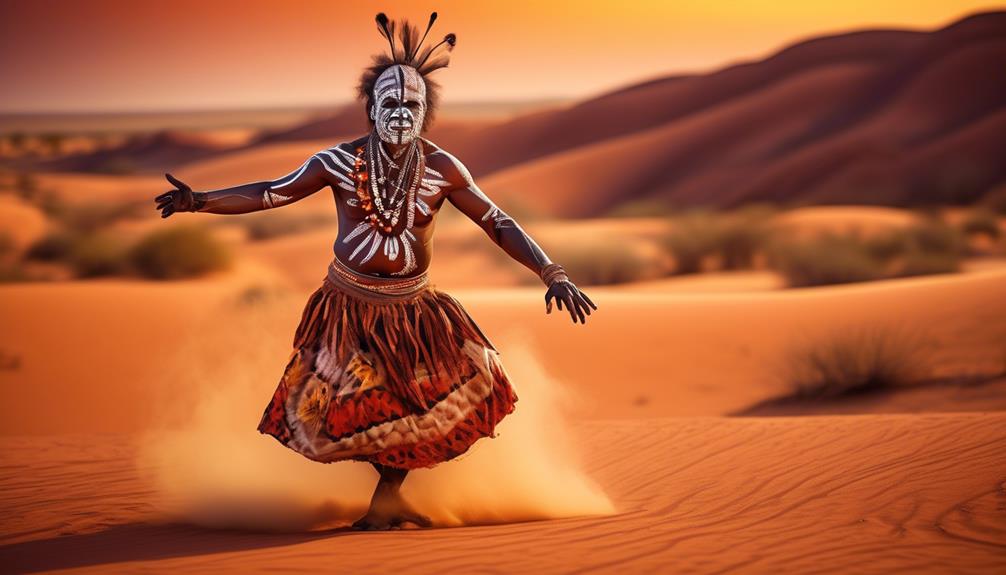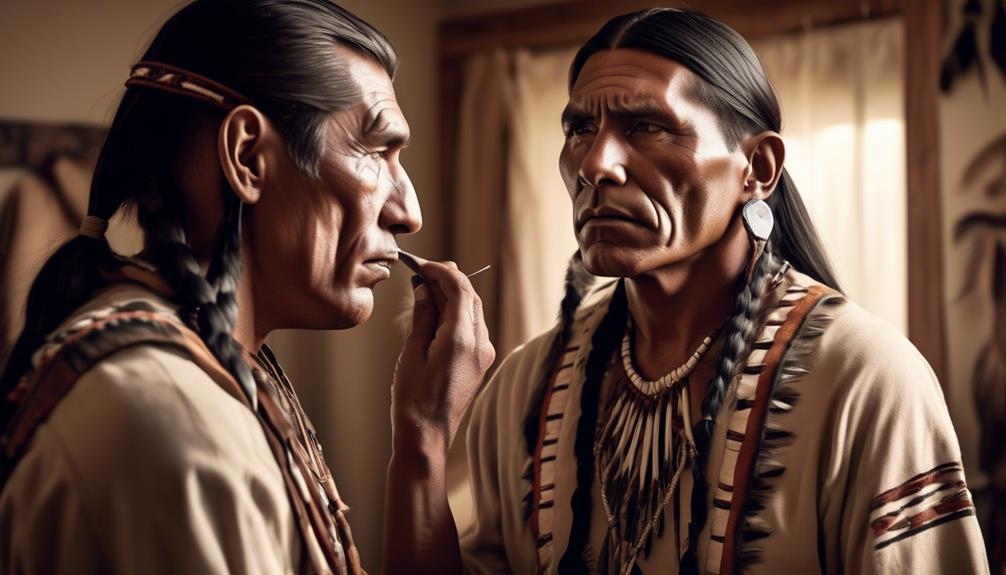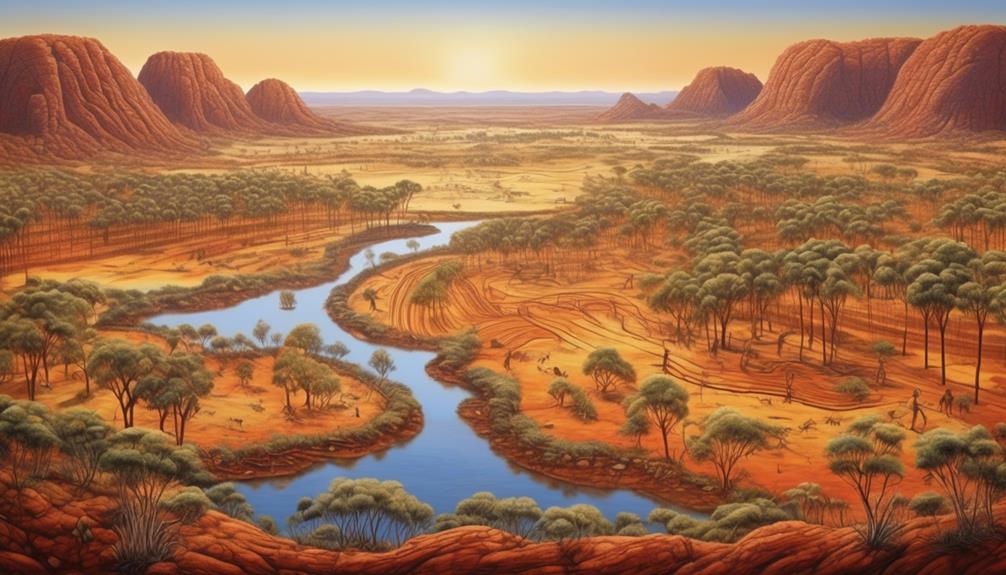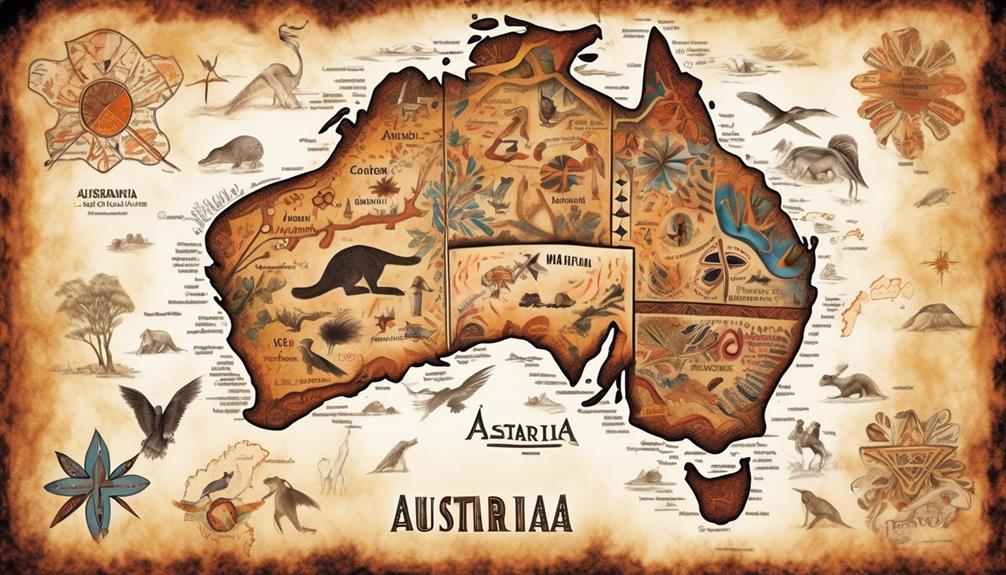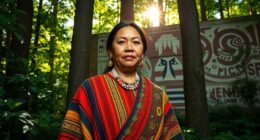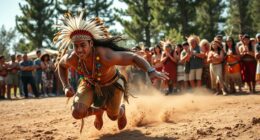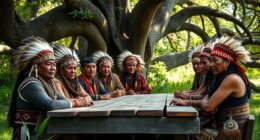It is well known that Australia has a rich and diverse culture, but did you know that Indigenous Australians have been residing on this land for over 65,000 years?
It's a staggering figure that speaks to the deep-rooted history and connection of the First Nations people to the land.
However, there's much more to uncover about the traditions, languages, and contributions of the Australian Aboriginal people that continue to shape the nation's identity and future.
Key Takeaways
- Aboriginal people have a deep spiritual connection to the land, which is fundamental to their traditional culture.
- The kinship system plays a crucial role in shaping relationships, responsibilities, and behaviors within Aboriginal communities.
- Aboriginal languages are integral to cultural identity and the preservation of traditions and knowledge.
- The impact of colonization has resulted in the loss of traditional practices, language, and land, leading to intergenerational trauma and disparities in health, education, and socio-economic opportunities.
The Origins of Aboriginal People
The origins of the Aboriginal people can be traced back thousands of years, revealing a rich and diverse history that's integral to the Australian landscape. Through genetic research, we're gaining a deeper understanding of the ancient origins of the Aboriginal people, shedding light on their unique heritage and connection to the land. This research has highlighted the remarkable resilience and adaptability of the Aboriginal people, who've thrived in diverse environments for millennia.
In addition to genetic research, the oral history traditions passed down through generations provide invaluable insights into the origins of the Aboriginal people. These oral histories, filled with wisdom and knowledge, offer a holistic understanding of the deep roots that tie the Aboriginal people to the land. They provide a rich tapestry of stories, traditions, and cultural practices that have sustained and enriched Aboriginal communities throughout time.
It is essential to approach the origins of the Aboriginal people with respect and collaboration, recognizing the significance of their history and its enduring relevance. By honoring their traditions and embracing a collaborative approach to understanding their origins, we can work towards liberation for all people, fostering a society that values diversity and inclusivity.
The origins of the Aboriginal people are a testament to the resilience, strength, and enduring spirit of a culture deeply intertwined with the Australian landscape.
Traditional Aboriginal Culture
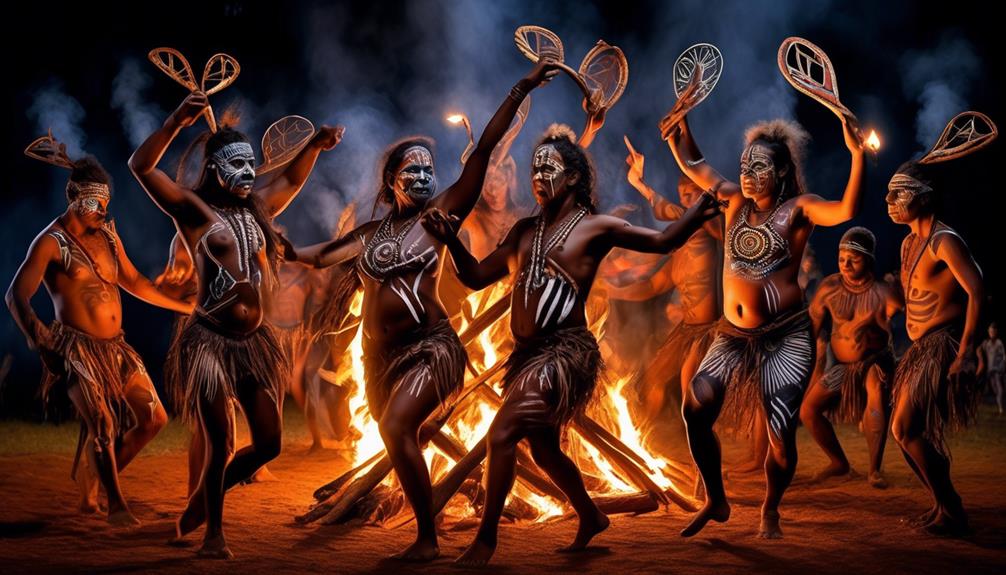
Let's explore the rich tapestry of traditional Aboriginal culture. This culture encompasses profound Dreamtime stories, a complex kinship system, and a deep spiritual connection to the land. These elements are integral to the holistic worldview of Aboriginal people and have been passed down through generations, shaping their identity and way of life.
Dreamtime Stories
In exploring the traditional Aboriginal culture, it's fascinating to delve into the profound significance of Dreamtime stories, which encapsulate the spiritual beliefs and cultural identity of the Australian Aboriginal people.
Dreamtime symbolism holds deep cultural significance, as it forms the basis of Aboriginal storytelling and artistic expression. These stories aren't just myths or legends; they're the essence of creation, connecting the past, present, and future. They convey the Aboriginal understanding of the world, including the landscape, animals, and natural phenomena.
Each story carries wisdom, morals, and guidance for living in harmony with the land and all living beings. By understanding Dreamtime stories, we honor the rich tradition and spirituality of the Aboriginal people, gaining insight into their profound connection to the land and the universe.
Kinship System
Understanding the kinship system in traditional Aboriginal culture provides valuable insight into the interconnectedness and societal structure of the community. Family dynamics are at the heart of the kinship system, shaping relationships, responsibilities, and behaviors. This system plays a crucial role in the social structure, defining roles and obligations within the community.
Cultural significance is deeply embedded in the kinship system, as it governs interactions, ceremonies, and the passing down of knowledge. Role allocation within the kinship system is based on reciprocity and mutual respect, emphasizing the collaborative nature of traditional Aboriginal culture. Each member has a specific role to play, contributing to the well-being of the entire community.
Connection to Land
With a deep reverence for the land, traditional Aboriginal culture embodies a profound sense of connection and stewardship towards the natural world. Our connection to the land is deeply rooted in our cultural beliefs and practices.
The land isn't just physical space; it holds our stories, traditions, and spiritual beliefs. It's the source of our identity and provides us with sustenance. Our cultural practices are deeply intertwined with the land, and we've a responsibility to protect and preserve it for future generations.
Land rights are crucial to maintaining our cultural significance and ensuring the continuation of our way of life. The land isn't just a possession; it's a part of our identity, and our connection to it's essential for our cultural survival.
Aboriginal Languages and Communication
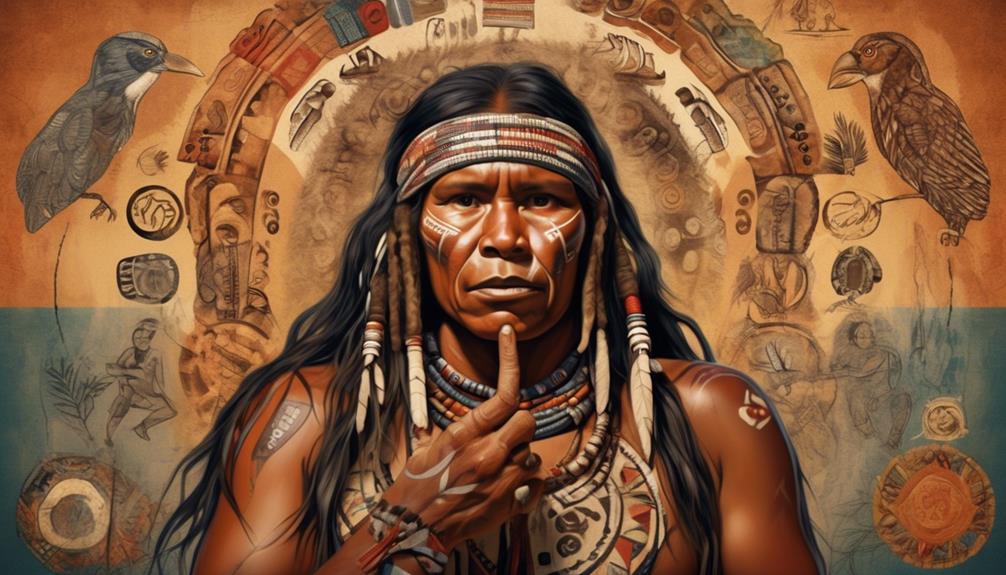
One of the fascinating aspects of Aboriginal cultures is the rich diversity of languages and communication systems utilized by different Aboriginal groups across Australia. Aboriginal languages are an integral part of our cultural identity and are essential for maintaining our connection to our heritage and ancestral lands. The preservation of Aboriginal languages is crucial for the continuity of our traditions and the passing down of knowledge from one generation to the next.
Cultural communication methods, such as storytelling, songlines, and art, play a significant role in how we pass on knowledge, history, and spiritual beliefs. These methods aren't only forms of communication but also serve as a way to maintain our cultural practices and preserve our languages. Through these methods, we continue to strengthen our connection to our ancestors and the land, ensuring that our traditions remain alive and vibrant.
Efforts to preserve and revitalize Aboriginal languages are ongoing, with community-led initiatives and educational programs playing a vital role in this endeavor. By working collaboratively with linguists, educators, and community members, we strive to document, teach, and celebrate our languages. It's through these collective efforts that we can ensure the survival and flourishing of our languages for future generations.
Our languages aren't just a means of communication; they're a repository of our knowledge, spirituality, and identity. As we continue to uphold and share our languages, we contribute to the richness and diversity of human expression and understanding.
Kinship and Social Structure
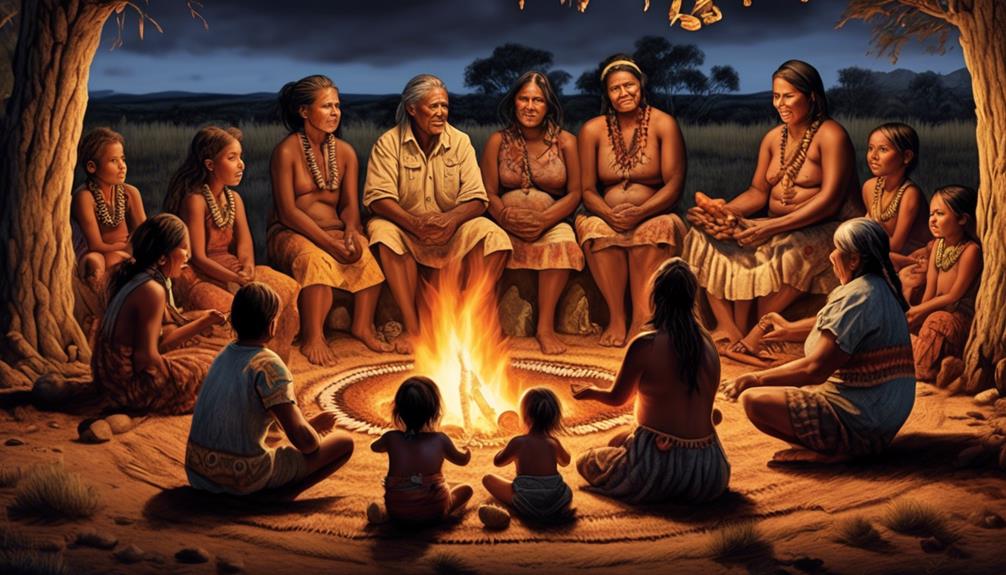
Let's explore the foundational role of family within Australian Aboriginal culture, serving as the basis for social organization and connection.
We'll also discuss the intricate role allocation system that governs responsibilities and relationships within the community.
Additionally, we'll delve into the deep cultural significance of kinship, highlighting its pivotal role in shaping Aboriginal social structure and identity.
Family as Basis
In Australian Aboriginal culture, family serves as the foundational structure for kinship and social relationships. Family dynamics are central to our way of life, shaping our identity, responsibilities, and connections within the community. The concept of family extends beyond the nuclear unit to include a vast network of relatives, each with distinct roles and obligations. Community support is inherent in our family structure, providing a sense of belonging, security, and guidance. Our kinship system is intricate, with relationships governed by strict customs and protocols that have been passed down through generations. This table illustrates the complexity and richness of Australian Aboriginal kinship, showcasing the diverse roles and connections within our familial and community networks.
| Kinship Role | Responsibilities |
|---|---|
| Parent | Nurturing and guidance for children |
| Elder | Sharing wisdom and upholding traditions |
| Sibling | Mutual support and companionship |
| Cousin | Building alliances and cooperation |
| Community Leader | Facilitating harmony and conflict resolution |
Role Allocation System
How does the kinship system of Australian Aboriginal people contribute to the allocation of roles within the community and the social structure?
The role allocation system within Australian Aboriginal communities is deeply intertwined with kinship structures and community leadership. Kinship connections define not only family relationships but also the distribution of roles and responsibilities within the community.
Through kinship, individuals are assigned specific roles based on their relationship to others and their connection to the land. This system promotes a collaborative approach to leadership, where decision-making and responsibilities are shared among community members based on their kinship ties and knowledge.
It fosters a holistic and inclusive approach to community governance, ensuring that everyone's voice is considered and valued. Furthermore, it emphasizes the interconnectedness of all community members, promoting a sense of collective responsibility and cooperation in maintaining social harmony and balance.
Cultural Significance of Kinship
The cultural significance of kinship within Australian Aboriginal communities is integral to the social structure, shaping the interconnected roles and responsibilities of individuals based on their kinship ties and connections to the land. This deep-rooted system influences every aspect of life, from family dynamics to cultural practices, and plays a pivotal role in shaping the community's identity and values.
- Interconnectedness: Kinship fosters a sense of interconnectedness, where every individual is intertwined within a complex web of relationships.
- Responsibilities: It delineates specific responsibilities and obligations towards family members and the wider community, creating a strong support system.
- Ceremonial Practices: Kinship determines ceremonial practices and rituals, strengthening the bonds between individuals and the land.
- Spiritual Beliefs: It influences spiritual beliefs and the transmission of cultural knowledge, ensuring the preservation of traditions across generations.
Aboriginal Dreamtime Stories
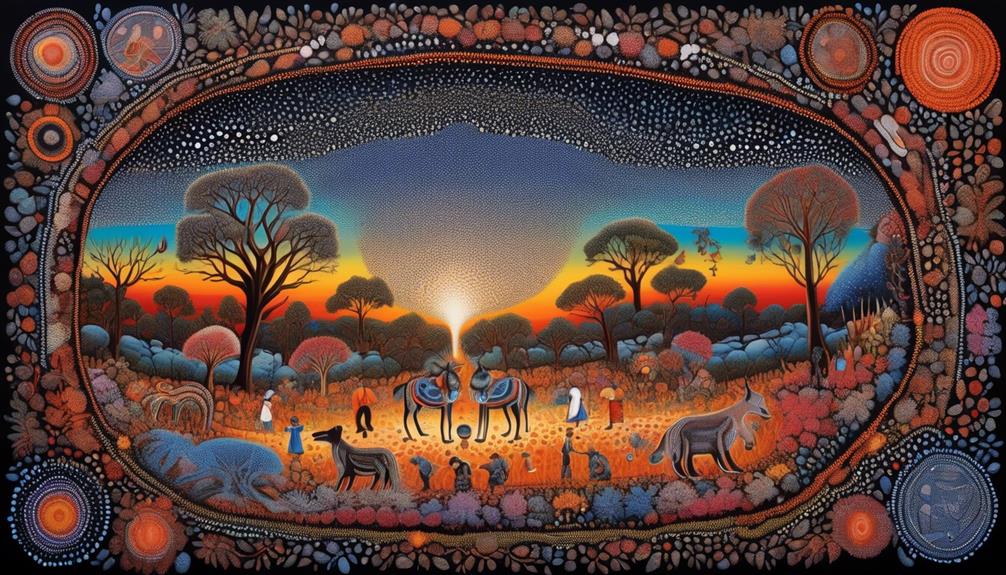
Aboriginal Dreamtime Stories play a central role in the cultural, spiritual, and historical identity of Australian Aboriginal people, providing a rich tapestry of creation narratives and ancestral teachings. Dreamtime storytelling is not just a form of entertainment; it is a way of passing down knowledge, traditions, and spiritual beliefs from one generation to the next. These stories are essential for the cultural preservation of Aboriginal communities and are deeply intertwined with their spiritual beliefs.
| Dreamtime Stories | Cultural Preservation | Spiritual Beliefs |
|---|---|---|
| Creation narratives | Transmitting knowledge | Connection to land |
| Ancestral teachings | Perpetuating traditions | Ancestral spirits |
| Spiritual significance | Strengthening identity | Sacred rituals |
Dreamtime stories are a source of guidance, teaching the importance of respect for the land, animals, and fellow human beings. They emphasize the interconnectedness of all living things and the responsibility to care for the natural world. These stories also carry the wisdom of the ancestors, guiding the community in ethical behavior, decision-making, and conflict resolution. Moreover, Dreamtime stories are deeply rooted in the spiritual beliefs of Aboriginal people, connecting them to the land, their ancestors, and the unseen spiritual forces that govern the universe.
Aboriginal Art and Music
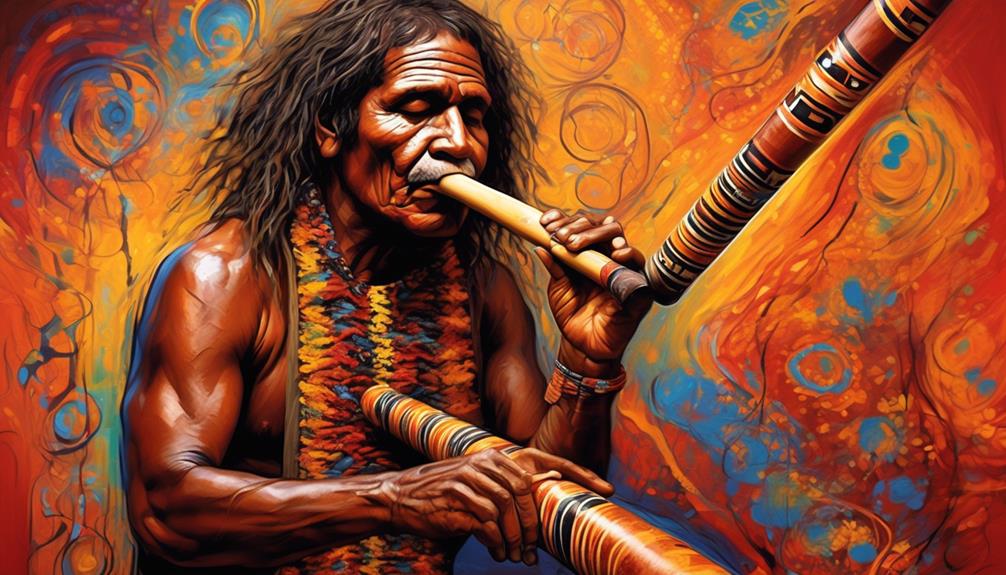
Let's explore the rich artistic tradition of Australian Aboriginal people, which is filled with symbolic representations of their cultural beliefs and traditions.
We'll also take a look at the traditional music instruments used by Aboriginal communities, each with its own unique significance and purpose.
Our discussion will provide insight into the deep connection between art, music, and the spiritual and cultural identity of the Aboriginal people.
Artistic Symbolism in Aboriginal Culture
Artistic symbolism in Australian Aboriginal culture is beautifully expressed through a rich tapestry of art and music, reflecting the deep spiritual connection to the land and ancestral stories.
- Dreamtime Stories: The art and music often depict Dreamtime stories, which are the creation myths and spiritual beliefs of the Aboriginal people.
- Dot Painting: Symbolic art is commonly found in dot paintings, representing the interconnectedness of all living things and the land.
- Didgeridoo: The didgeridoo, a traditional Aboriginal musical instrument, is used to tell stories through its deep, resonant sounds.
- Ceremonial Dance: Artistic representation is also seen in ceremonial dances that convey cultural knowledge and spiritual significance through movement and song.
This cultural expression is deeply rooted in the storytelling tradition, providing a profound connection to the land and a sense of continuity with ancestral wisdom.
Traditional Music Instruments
In exploring the rich cultural heritage of the Australian Aboriginal people, we are drawn to the traditional music instruments that play a significant role in expressing their deep spiritual connection to the land and ancestral stories. Aboriginal music is a vibrant tapestry woven with cultural instruments, each carrying its own unique significance. The didgeridoo, for instance, embodies the sounds of the Australian outback and is deeply intertwined with Aboriginal spirituality. The clapsticks, used to produce rhythmic patterns, symbolize the heartbeat of the land and its creatures. Another essential instrument is the bullroarer, creating a haunting sound that evokes the voices of ancestral spirits. These cultural instruments are not merely tools for music but are sacred artifacts, carrying the essence of Aboriginal identity and tradition.
| Traditional Music Instruments | Description | Significance |
|---|---|---|
| Didgeridoo | Embodies outback sounds | Deeply intertwined with spirituality |
| Clapsticks | Produce rhythmic patterns | Symbolize the heartbeat of the land and its creatures |
| Bullroarer | Creates haunting sound | Evokes the voices of ancestral spirits |
Impact of Colonization
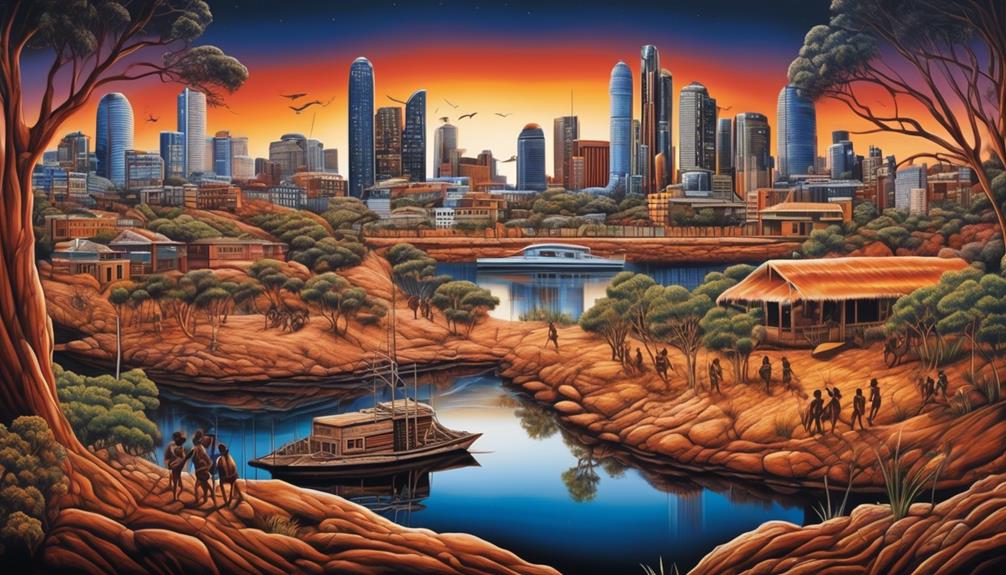
The impact of colonization on Australian Aboriginal people has been profound, resulting in significant cultural, social, and economic changes. This has deeply affected our communities and continues to shape our experiences today.
- Loss of Traditional Practices: The arrival of European settlers led to the erosion of our traditional practices, including language, ceremonies, and land management techniques. This loss has severed our connection to our ancestral lands and disrupted the passing down of cultural knowledge through generations.
- Intergenerational Trauma: The trauma inflicted upon our ancestors during colonization has had enduring effects on our communities. The violence, dispossession, and forced assimilation have resulted in intergenerational trauma, impacting mental health, social relationships, and overall well-being.
- Cultural Resilience: Despite the challenges, our communities have demonstrated remarkable resilience in preserving and revitalizing our cultural practices. Through art, storytelling, and activism, we're reclaiming our identity and continuing the legacy of our ancestors.
- Economic Disparities: Colonization has perpetuated economic disparities within our communities, leading to higher rates of poverty, unemployment, and inadequate access to essential services. These disparities have further entrenched social inequality and marginalization.
As we confront the enduring impacts of colonization, it's essential to acknowledge the strength and resilience of our communities. By fostering understanding and supporting initiatives that empower and uplift Aboriginal voices, we can work towards healing the wounds of the past and creating a more equitable future.
Stolen Generations
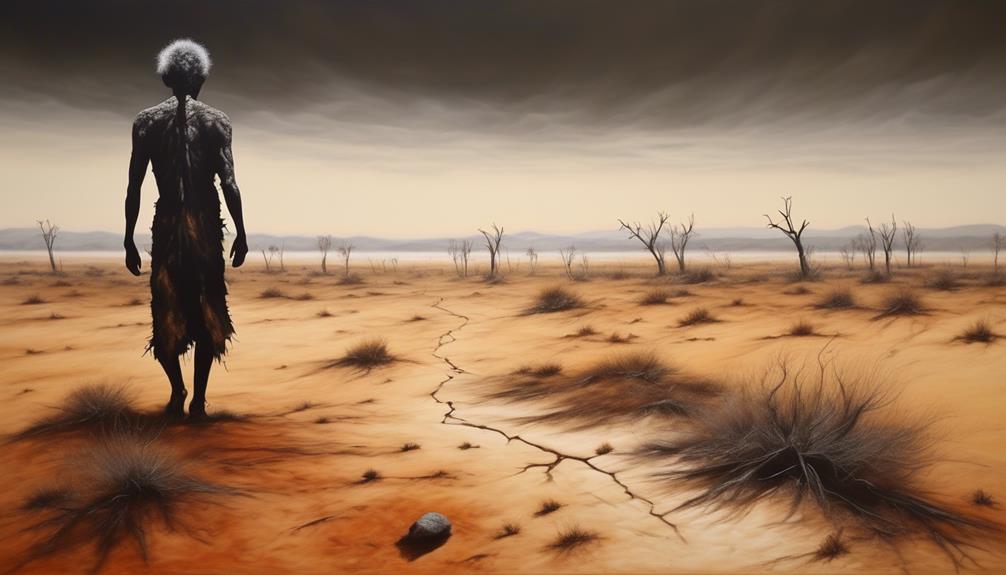
The lasting effects of colonization on Australian Aboriginal people are notably reflected in the painful history of the Stolen Generations, a period of systemic removal of Indigenous children from their families and communities. The impact of this traumatic chapter continues to reverberate through generations, leaving deep scars of intergenerational trauma. The forced separation from family, culture, and language has had profound and enduring effects on the social, emotional, and psychological well-being of the individuals and the community as a whole.
Healing and reconciliation are ongoing processes that require collective efforts and a commitment to truth-telling and understanding. It's essential to acknowledge the historical injustices and their enduring impact. By creating safe spaces for open dialogue and actively listening to the experiences of those affected, we can promote healing and foster a sense of unity. Through genuine reconciliation, we can work towards rebuilding trust and creating a more equitable and inclusive society.
In our journey towards healing and reconciliation, it's crucial to uplift the voices of the affected communities and honor their resilience. By centering their stories and experiences, we can cultivate a deeper understanding of the profound impact of the Stolen Generations and work towards meaningful redress. Together, we can forge a path towards healing, acknowledging the past while creating a more just and compassionate future for all.
Land Rights and Connection to Country
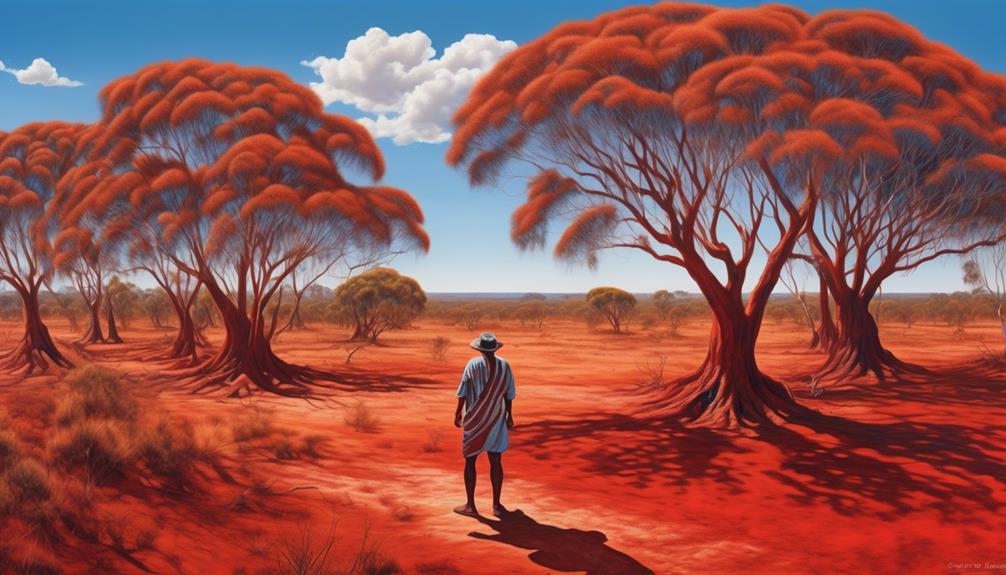
We, as Aboriginal people, hold a deep and enduring connection to our traditional lands, which have sustained us for thousands of years. Our cultural identity and spirituality are intimately tied to the land, and it shapes our sense of belonging and wellbeing.
However, the impact of land dispossession has had profound and lasting effects on our communities, disrupting our cultural practices and traditional way of life.
Traditional Land Ownership
With a deep spiritual connection to our ancestral lands, Australian Aboriginal people have a profound understanding of traditional land ownership that transcends legal boundaries. Our cultural practices and traditional knowledge are deeply intertwined with the land, shaping our identity and spirituality. Our connection to country is a vital part of our existence, and it's essential for maintaining our cultural heritage and wellbeing.
This connection influences our sense of responsibility, stewardship, and custodianship of the land. We honor the land as a source of life and sustenance, and our traditions emphasize the need for sustainable land management.
Our ongoing struggle for land rights isn't just a legal battle; it's a fight for the preservation of our cultural significance and the protection of our deep-rooted connection to country.
Cultural Significance of Land
Deeply embedded within our cultural practices and spiritual identity, the enduring struggle for land rights reflects our ongoing connection to country and its profound significance to our people.
The land isn't just physical space; it embodies our history, spirituality, and identity. Our spiritual connection to land is a foundation of our existence, carrying intergenerational knowledge and wisdom. It's where our stories, traditions, and ceremonies unfold, forming the essence of our being.
Our fight for land rights isn't just a legal or political matter; it's about preserving our heritage and maintaining the balance of nature. When we protect our land, we're safeguarding our culture and spirituality for future generations.
Our journey for land rights is a testament to our resilience and unwavering commitment to honor the interconnectedness of all life on this land.
Impact of Land Dispossession
Despite the enduring struggle for land rights, the impact of land dispossession has profoundly affected our connection to country and our cultural identity. This ongoing challenge has led to significant repercussions, including:
- Disruption of our spiritual and physical connection to the land
- Loss of traditional knowledge and practices related to land stewardship
- Intergenerational trauma due to forced removal from ancestral lands
- Struggle for recognition of Aboriginal rights and self-determination
The fight for land rights activism continues to be a vital aspect of our quest for justice and healing. The impact of dispossession has also reverberated through the stolen generations, further underscoring the need for reconciliation and restoration of our connection to country.
Our journey towards liberation and empowerment involves reclaiming our land, culture, and identity, forging a path towards a more equitable and inclusive future.
Contemporary Aboriginal Issues
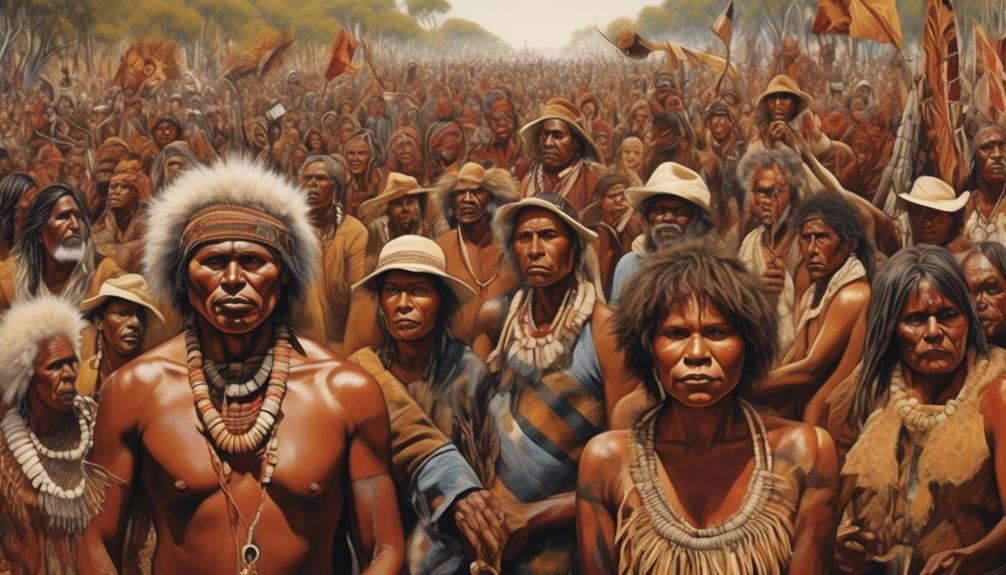
Contemporary issues affecting Australian Aboriginal people encompass a wide range of complex challenges that require thoughtful consideration and collaborative solutions. One of the most pressing contemporary challenges is the inadequate political representation of Aboriginal people at both the state and federal levels. Despite some progress, there remains a significant underrepresentation of Aboriginal voices in decision-making processes that directly affect their communities. This lack of representation perpetuates a cycle of marginalization and hinders the advancement of policies that address the specific needs and concerns of Aboriginal populations.
Moreover, contemporary challenges also include disparities in health, education, and socio-economic opportunities. These issues are deeply interconnected and stem from a history of systemic discrimination and dispossession. Addressing these challenges requires a holistic approach that acknowledges the interconnectedness of social determinants and advocates for comprehensive solutions.
To move forward, it's crucial to engage in meaningful dialogue with Aboriginal communities and prioritize their self-determination. Collaborative efforts that center Indigenous knowledge and perspectives are essential for creating sustainable and effective solutions. Furthermore, fostering genuine partnerships between Aboriginal peoples and government entities is vital to ensure that policies and programs are culturally sensitive, responsive, and empowering.
In confronting contemporary challenges, it's imperative to recognize the resilience, wisdom, and diversity of Aboriginal cultures. By working together in a spirit of respect and solidarity, we can strive towards a future where Aboriginal peoples have equitable representation and access to opportunities, contributing to a more just and inclusive society for all.
Aboriginal Activism and Advocacy
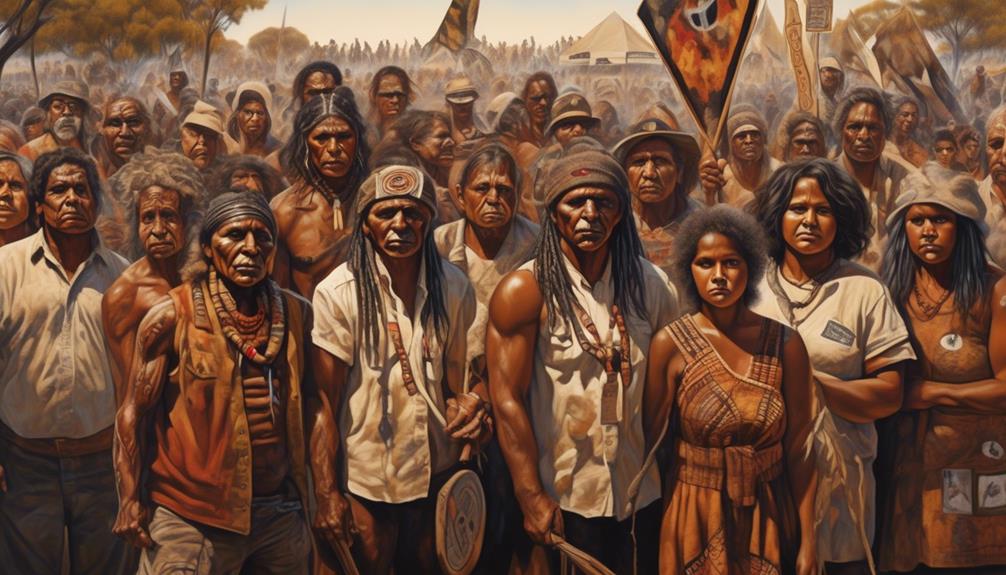
In our collective efforts to support the rights and empowerment of Australian Aboriginal people, advocacy and activism play a crucial role in amplifying their voices and promoting positive change.
Aboriginal activism and advocacy are essential components of the ongoing struggle for indigenous rights and social justice. Here are some key aspects of Aboriginal activism and advocacy that are shaping the current landscape:
- Grassroots Movements: Grassroots movements led by Aboriginal communities are at the forefront of advocating for their rights and driving positive change within their own communities.
- Legal Advocacy: Legal advocacy initiatives are instrumental in pursuing legal avenues to protect indigenous rights, challenge discriminatory policies, and seek justice for historical injustices.
- Cultural Preservation: Activism and advocacy efforts are dedicated to preserving and celebrating Aboriginal culture, language, and traditions, recognizing them as valuable aspects of Australia's heritage.
- Collaborative Partnerships: Building collaborative partnerships with non-Indigenous allies, organizations, and government entities is vital for amplifying the voices of Aboriginal people and creating meaningful change.
Aboriginal activism and advocacy are multidimensional, encompassing various approaches to address systemic inequalities and promote the rights and well-being of Aboriginal people.
Aboriginal Contributions to Australian Society
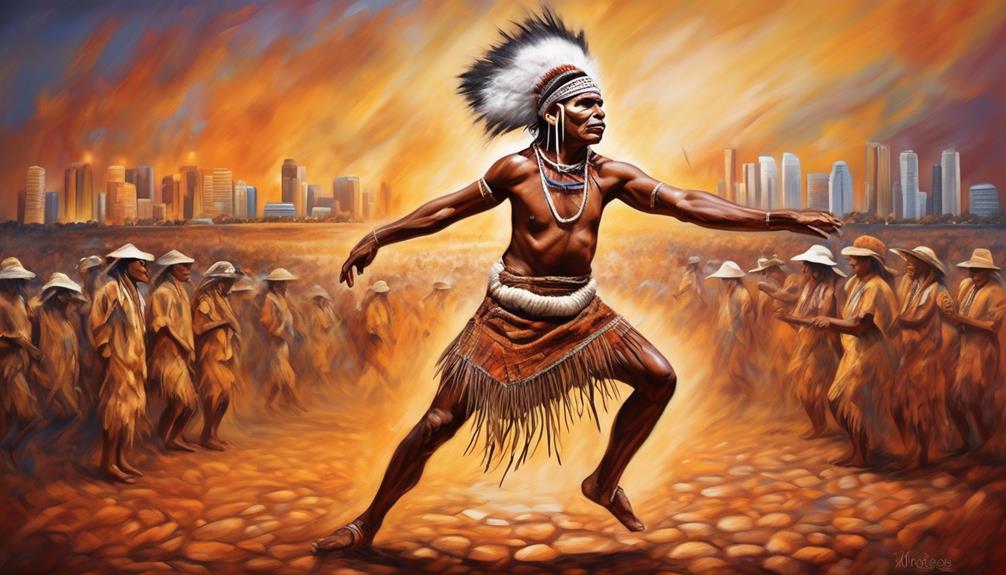
As we continue our exploration of the Australian Aboriginal people's experiences and contributions, it's essential to acknowledge their profound impact on Australian society across various domains.
One of the most notable contributions is in the realm of art. Aboriginal art holds significant cultural and historical value, and it has made a lasting impression on the global art scene. The vibrant and intricate designs, often depicting Dreamtime stories and traditional symbols, aren't only visually stunning but also serve as a means of cultural preservation, ensuring that the rich traditions and stories of the Aboriginal people are passed down through generations.
In addition to artistic contributions, Aboriginal people have played a pivotal role in the economic landscape of Australia. Their contributions to various industries, such as agriculture, mining, and tourism, have been substantial. Moreover, their deep understanding of the land has often led to sustainable practices that benefit both the environment and the economy.
Furthermore, the advocacy for political representation has been a significant contribution. The fight for indigenous rights and self-determination has led to increased political representation and a stronger voice in shaping policies that affect Aboriginal communities. This has resulted in a more inclusive and diverse political landscape, amplifying the voices of those who've historically been marginalized.
In essence, the contributions of the Aboriginal people to Australian society encompass a wide range of domains, from art and economics to political representation, and their impact continues to shape the nation in profound ways.
Government Policies and Reconciliation
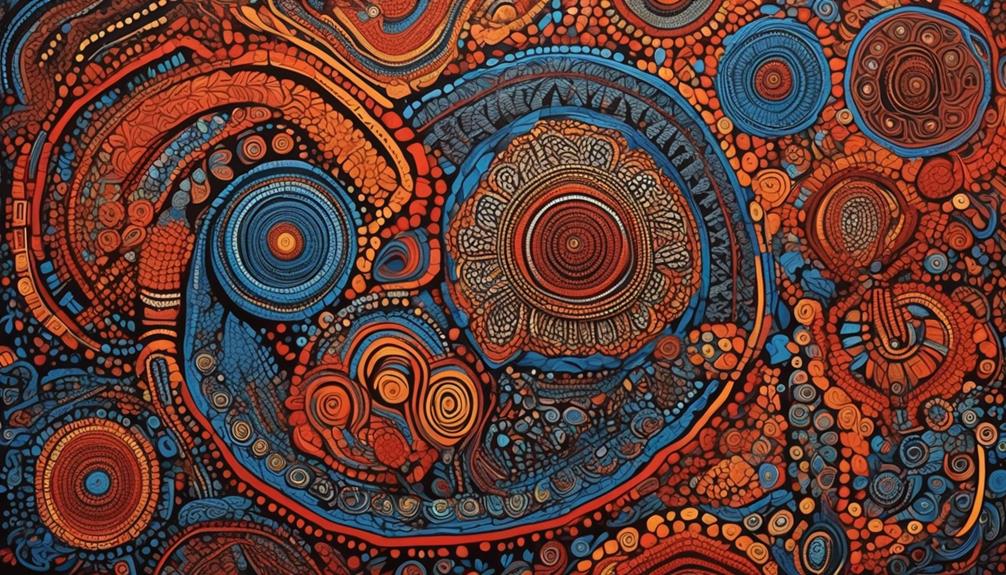
A thoughtful and inclusive approach to government policies has been crucial in fostering reconciliation and addressing historical injustices faced by the Australian Aboriginal people. It's vital to recognize that the road to reconciliation is ongoing, and government policies play a pivotal role in shaping the future for Aboriginal communities.
Here are some key aspects to consider in the current landscape of government policies and reconciliation efforts:
- Cultural Competency Training: Ensuring that all government officials receive comprehensive training to understand and respect the cultural beliefs and practices of Aboriginal people. This helps in creating an environment of mutual respect and understanding.
- Community Consultation: Prioritizing meaningful engagement with Aboriginal communities when developing and implementing policies that directly affect them. This approach ensures that their voices are heard and their needs are taken into account.
- Land Rights and Resource Allocation: Implementing policies that recognize and protect the land rights of Aboriginal people, as well as ensuring fair and equitable distribution of resources to support community development and economic sustainability.
- Truth and Reconciliation Commission: Establishing a platform for truth-telling, acknowledgment of past wrongs, and creating pathways for healing and reconciliation. This initiative allows for a collective understanding of historical injustices and paves the way for a more harmonious future.
The journey towards reconciliation requires a collaborative and respectful approach, where the voices and experiences of Aboriginal people are central to the development and implementation of government policies. Through such efforts, we can work towards a future that upholds the rights, dignity, and liberation of the Australian Aboriginal people.
Celebrating Aboriginal Heritage
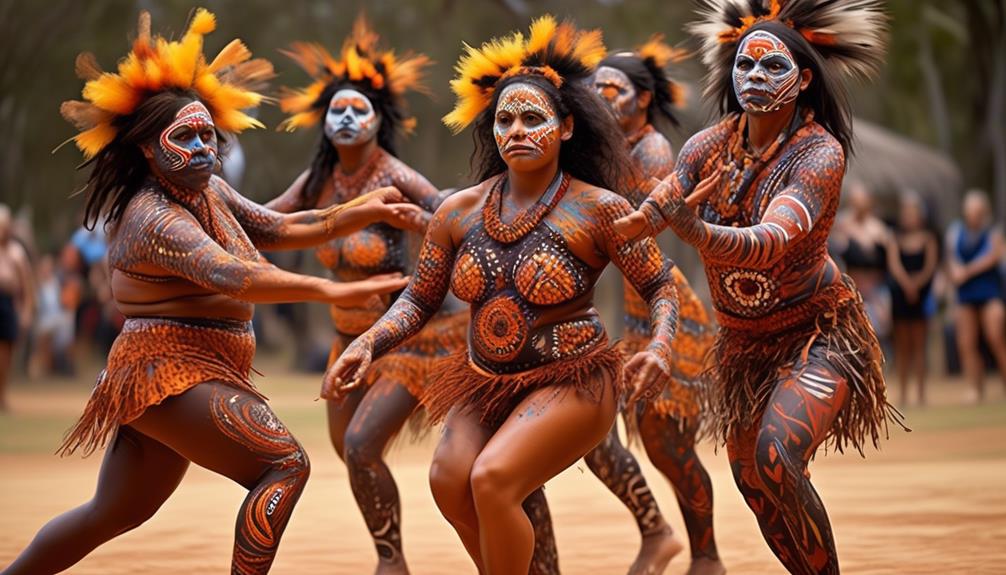
Acknowledging the importance of fostering reconciliation and respecting the cultural heritage of the Australian Aboriginal people, celebrating their rich and diverse heritage becomes a meaningful endeavor that requires collective participation and genuine engagement. As we celebrate traditions and seek to preserve the cultural legacy of the Aboriginal people, it is imperative to engage in meaningful and respectful ways. We must honor their customs, art, language, and spirituality, recognizing the depth and richness of their heritage. By doing so, we not only acknowledge the past but also ensure that their traditions are passed on to future generations, fostering a sense of pride and belonging.
| Tradition | Importance | Action |
|---|---|---|
| Dreamtime Stories | Connection to ancestors and land | Support and promote storytelling events |
| Art and Ceremonies | Expressing cultural identity and spirituality | Encourage participation and appreciation |
| Language | Preserving unique ways of communication | Support language revitalization efforts |
| Connection to Land | Sacred relationship with the environment | Respect sacred sites and conservation |
| Music and Dance | Expression of cultural stories and celebration | Attend and support cultural performances |
Celebrating Aboriginal heritage is a collaborative effort that requires active involvement and support. By participating in these actions, we contribute to the preservation and revitalization of their cultural practices. Let us engage in these endeavors with respect, mindfulness, and a genuine commitment to honoring the Aboriginal people and their heritage.
Future of Aboriginal People
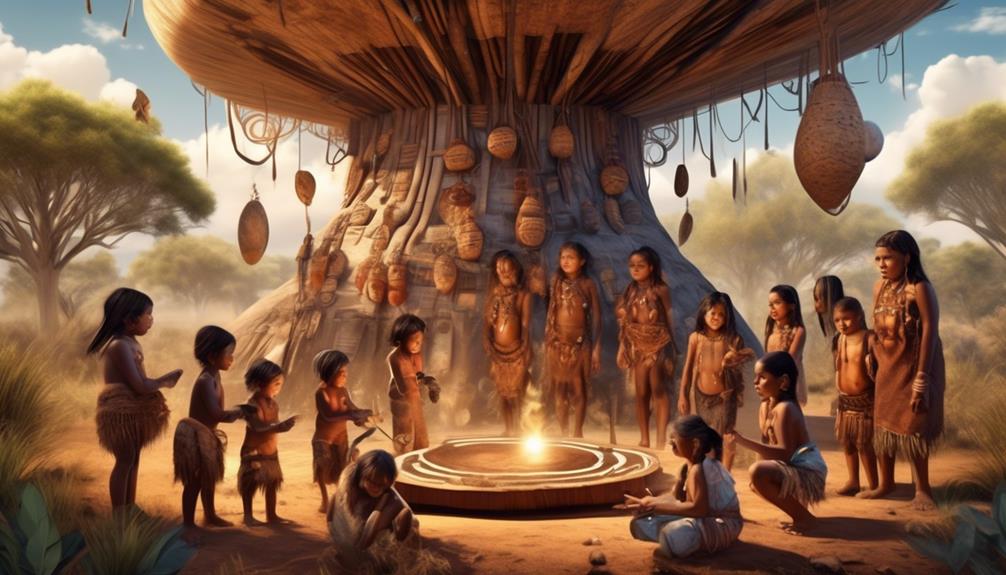
Exploring the sustainable advancement of Australian Aboriginal communities is essential for ensuring a thriving future for the Aboriginal people. We believe in a future where Aboriginal communities have access to education opportunities and economic empowerment, where healthcare access is equitable, and where community development is at the forefront of progress.
- Education Opportunities: We advocate for culturally sensitive and inclusive education systems that empower Aboriginal youth and adults to thrive in their chosen fields.
- Economic Empowerment: We strive for economic initiatives that support Aboriginal entrepreneurship, employment, and financial independence, fostering self-sufficiency within Aboriginal communities.
- Healthcare Access: We work towards improving healthcare access and addressing health disparities to ensure the physical, mental, and emotional well-being of Aboriginal people.
- Community Development: We support sustainable community development projects that are led by Aboriginal voices, preserving cultural heritage while fostering growth and progress.
We recognize the importance of respecting and preserving the cultural heritage and traditions of Aboriginal communities while also advocating for their advancement and liberation. The future of the Aboriginal people lies in collective efforts to address systemic barriers, promote inclusivity, and empower individuals and communities.
Frequently Asked Questions
How Do Aboriginal People Traditionally Prepare Their Food?
We prepare our food using traditional cooking methods, indigenous recipes, and cultural food practices. Our cuisine reflects our native food preparation techniques and indigenous culinary traditions.
We honor our heritage by preserving these time-honored practices, which are deeply rooted in our culture. This approach allows us to connect with our ancestors and the land, creating a holistic and respectful relationship with the food we consume.
What Are the Different Types of Aboriginal Art and Their Significance?
Different cultures around the world use art to express their beliefs and traditions. Traditional techniques and symbolic representation play a significant role in various forms of art.
Dot painting, for example, is a style that carries deep meaning and symbolism. Dreamtime stories are another important aspect of indigenous art, often depicted through intricate designs and symbols.
These art forms serve as a way to preserve and share cultural knowledge and history.
What Are Some Common Misconceptions About Aboriginal Culture?
Misconceptions about cultural practices can stem from lack of understanding. It's important to recognize the impact of colonial history and strive for accurate knowledge.
Preserving language is vital for cultural continuity. We must work together to shed light on these misconceptions and promote a more accurate understanding of indigenous cultures.
How Do Aboriginal People Navigate Their Kinship and Social Structure in Modern Society?
Navigating kinship dynamics and social integration in modern society involves embracing change while honoring traditions.
We prioritize maintaining our connections and upholding our values while adapting to new ways of living.
It's about striking a balance between preserving our cultural identity and participating in the broader community.
What Are Some Examples of Contemporary Aboriginal Activism and Advocacy Efforts?
In contemporary society, activism and social justice initiatives play a crucial role in advocating for positive change. Many groups and individuals are working tirelessly to address pressing issues, raise awareness, and push for meaningful reforms.
Through strategic campaigns, grassroots organizing, and community engagement, these efforts are making a tangible impact. It's inspiring to see the dedication and passion of those involved in advocating for a more just and equitable world.
Conclusion
As we look to the future of Australian Aboriginal people, we see a rich tapestry of culture and history woven into the fabric of our nation.
Their traditional stories and deep connection to the land paint a vivid picture of resilience and strength.
We celebrate their contributions and honor their heritage, as we work together towards a future of unity and understanding.
The spirit of the Aboriginal people will always be an integral part of Australia's identity.
Talise is a talented writer and an expert in her field. Her unique perspective and insights enrich our content with depth and authenticity. With a wealth of knowledge and a strong connection to the subjects she writes about, Talise crafts engaging and informative articles that resonate with our readers. Her dedication to bringing Indigenous culture and wisdom to light is truly commendable.
